Braun FS-120 medium format film scanner test report
After selling high value 35mm film magazine scanners for many years the Germany company Braun Phototechnik GmbH from Nürnberg released the first medium format scanner in July 2013. It is the FS-120, a device both for scanning medium format films (120/220 roll films) and for digitizing framed 35mm films or 35mm film strips, respectively.
The scanner makes a premium quality impression from outside. With a nominal resolution of 3200 dpi, a colour depth of 48 bit and a maximum density of greater than 3,6 (manufacturer's data) one can expect high-value scans. Furthermore, the device is equipped by default with the professional scan software SilverFast Ai Studio. As the Multimag SlideScan series, the FS-120 is very similar to the corresponding model of reflecta. How that medium format scanner from Braun Phototechnik proves in practice, how good the image quality is, and especially how it compares to the Reflecta MF5000 and the Nikon 9000, we will see in the following review.
The Braun FS-120 is not available any more since March 2021. There is no successof for it.
Equipment, accessoires and performance data of the scanner Braun FS-120
Whilst you have to provide a lot of space on your desk when working with flatbed scanners or with the Nikon 9000, then Braun FS-120 promises not to take too much space on your desk with its dimensions of 320x165x160 mm and its weight of only 5,3 kg. In the scope of delivery there is everything included which you need in order to digitzie your medium format films and 35mm films with the Braun FS-120. Not least by the scan software Silverfast Ai Studio 8 there are no remaining requests in terms of equipment. There is also the manufacturer's software CyberView in the package, however, you will seldomly need it if you have the SilverFast licence included.
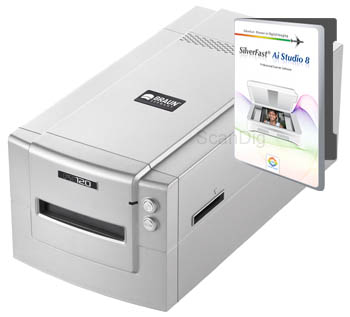
There are three film holders included in the scope of delivery: the 35mm slide holder for 4 mounted slides, the film holder for 35mm film strips of maximum 6 frames, and the medium format film holder for film strips up to a length of 22 cm. At the scanner one can recognize very quickly, that the 35mm film holders have to be inserted into the scanner at the slot on the side. For the medium format film holder there is a bigger slot at the front of the scanner. At this slot there is a protective cap in order to protect the interior of the scanner from dust. Furthermore at the front sidt there is an on/off button, a scan button and a blue status LED beside the on/off button.
At the back side of the scanner the FS-120 has an USB 2.0 interface and an electrical connection. If you look at the top side of the scanner you might get the idea that there are ventilation slots in the rear third of the case. When looking at them exactly, however, you will recognize that they are just for decoration purpose. The scanners stands firmly on four small rubber foots which can damp small vibrations very well. The case itself seems like the Nikon scanners to be out of metal because of its silvern colour, however it is made of plastic.
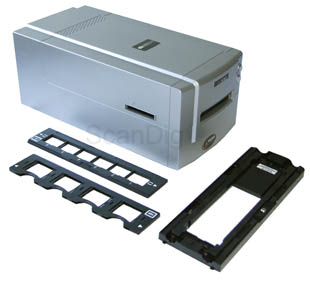
Let's look at the manufacturer's data. Whilst many other scanners are declared with resolutions far away from what you can imagine, Braun gives an optical resolution of 3200 dpi for the 3 line CCD sensor. At the first glue it seams to be rather low, however, it could be a good sign, that our results of the resolution test will not deviate far from the manufacturer's value. If that is the case or not we will see in the chapter image quality. The given maximum density of larger than 3,6 is rather standard, it is even beaten by many other film scanners. One can conclude that the density range lies in the range of 3,0. So one has to expect damages in very bright and very dark image areas of high-contrast films. As the magazine scanner Braun Multimag SlideScan 6000 the FS-120 has the MAGIC TOUCH technology for automatically correcting dust and scratches included. The MAGIC TOUCH logo is labeled at the front side of the scanner.
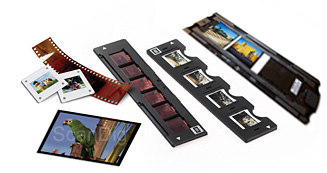
Finally let's answer the question which film formats there can be scanned in the medium format field. The standard formats 6x4,5 cm, 6x6 cm, 6x7 cm, 6x8 cm and 6x9 cm can be digitized, and also fans of the medium format panorama photography will get their money worth, since also 6x12 cm films can be scanned with the Braun FS-120. A small consolation for extreme panorama photographers up to 6x19 cm is, that you can insert film strips with a length of maximum 22cm into the medium format film holder. So you can turn the film after the first half and then scan the other half. Afterwards you have to compose the two scans in the image editing software - a time consuming procedure, however, a method with which you can digitize very large medium format panorama films.
Installation and setup of the scanner Braun FS-120
After unpacking the scanner and putting it on the desk you first have to install the SilverFast scan software on your PC. After that installation and a restart of your computer you can connect the scanner via USB 2.0 interface. Best you use a USB port which is directly connected with the motherboard of your computer; these are usually on the back side of your PC. You should also do without a USB hub. This often leads to problems at the connection. Then you provide the electrical power supply with the included power supply. Then you can switch on the scanner with the on/off button at the front side.

The blue LED starts blinking, the scanners makes it's first noises and the PC displays the message "new hardware found". This procedure takes almost one minute. As soon as the PC indicates that the new hardware has been installed and the blue LED glows permanently blue, the scanner is ready for operation. You can now start the SilverFast scan software. It is recommendable to make the registration immediately and check the software for new updates. Especially it is inevitable to make an update if your version number is older than 8.0.1r26. Since the Braun FS120 is not supported from SilverFast versions below 8.0.1r26. The update can be done via the Lasersoft Imaging homepage or the service dialogue at the start window of the software.
SilverFast can be run in 10 different languages. There is no extra installation necessary for a different language. At the starting window of SilverFast the language can be chosen below the image source.

In the starting window of SilverFast the image source is given as "Reflecta MF 5000 USB". If you start the software, it displays "Silverfast 8.0 Braun FS120". This is a clear indication that there are more differences between the Braun FS-120 and the similar reflecta MF-5000 except for the type designation and the manufacturer's name. If you have inserted the medium format film holder there is also indicated 120mm. If you insert the film holder into the scanner not before starting the software, it displays "load new film holder. SilverFast 8 will be restarted then". After confirming this message SilverFast will be restarted and you can start scanning.
Scanning of mounted 35mm slides with the Braun FS-120
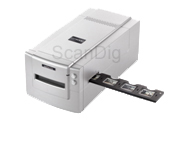
Even if it is certainly the main objective of a Braun FS-120 buyer to scan 120/220 medium format roll films, we first start with the possibility to scan slides in the 35mm format, since from these film type most medium format photographers also have many in their archive. In order to scan 35mm slides they have to be inserted in the corresponding film holder. In the slide mount holder you can insert up to 4 slides. As maximum thickness there is 3,2 mm allowed.
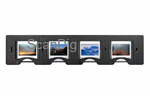
The slide holder has four semicircular openings at one side. They help for simply taking out the slides out of the slide mount holder. There are white arrows at the left and right side of the slide mount holder, and there is additionally a white rectangle with the letters "abc". This helps to insert the slide mount holder accurate to side into the scanner, and the arrows indicate how the slide mount holder has to be inserted into the scanner. As already mentioned over the slot at the scanners there are also arrows, which have to match with the arrows on the film holders.
In order to protect the interior of the scanner from dust and dirt, we strongly recommend to clean the mounted slides before scanning with compressed air or with an anti static brush. So raw dust and fluff stay outside of the scanner, and the automatic dust and scratch correction function MAGIC TOUCH removes fine dust and scratches.
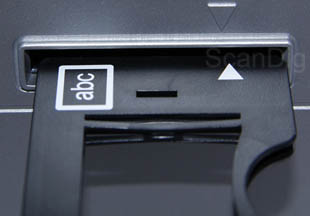
After inserting your slides into the slide mount holder you can insert it into the scanner. It does not matter if you insert it on the left or on the right side. The white arrow of the slide mount holder and the silvern arrow at the scanner have to match. The slide mount holder has to be pushed into the scanner so far until the first resistance can be noticed. The holder is then snapped at the first scan position. Since the Braun FS-120 does not have an automatic transport for the slide mount holder as for example the Nikon Super Coolscan 9000 ED, you have to forward the slide mount holder after each scan by one position. Hence the automatic scanning of four slides is not possible.
For scanning you have all functions of the SilverFast 8 software. It is recommendable to make an IT-8 colour calibration with separately available targets. First you make a prescan, then you make the scan settings according to your ambitions, and finally you start the scan. If the scan is done you push the slide mount holder to its next position.
At best you bridge the scanning time if you use the ArchiveSuite of the SilverFast scan software. With that procedure you digitize the slides within SilverFast Ai Studio as raw data in the HDR(i) Format. So it is not necessary to make individual settings (e.g. tone values, gradation etc.). If the first image is scanned you push the slide mount holder at its next position and start the next scan. While the second image is beeing scanned you can process and store the first scan in SilverFast HDR Studio. So you can realize a continuous work flow even without an automatic film holder transportation mechanism. Detailed information about scanning with raw data can be found on our page about SilverFast HDR.
Scanning of 35mm film strips with the Braun FS-120
Scanning of 35mm film strips is quite similar to scanning mounted slides. The film holder, however, takes film strips or singular films up to 6 frames. On the film holder, which was included in the delivery content of our test device, the white arrows were in the middle. This can cause confusion since they do not conform to the arrows at the scanner. So we better oriented at the symbol with the letters "abc". As for the slide mount holder these characters have to be upside down. Compared to the slide mount holder the slots of the film strip holder are numbered from one to six.
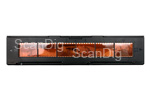
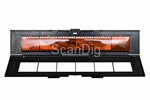
The film strip holder can be swinged open backwards. In order to do this the locking, which is located beween picture three and for, has to be dissolved. Just pull out the furrowed plastic rectangle a piece in arrow direction and then you can open the film holder. After inserting the films close the film holder and push back the locking. Due to the numbering it is recommendable to lead the film strip holder from left to right into the scanner. The scan procedure itself does not differ from scanning mounted slides. However, it is noticeable, that you cannot only insert a single long film strip into the film strip holder but also two small film strips or even singular negatives. The insertion of singular films, however, is a time-consuming matter, since the films get out of place again and again. Here help special tweezers, in order to grab and position the singular films better.
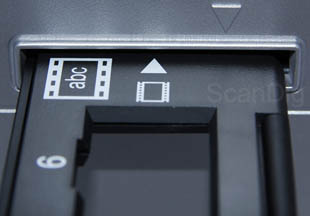
For cleaning negative strips we recommend to free them from dust using a anti static brush. So rough dust does not get into the scanner. And if nevertheless dust gets into the scanner mostly you realize it when bands in scan direction occur. In that case the best solution is to use a compressed air spray, thus spraying into the slots on the left and right side of the scanner. So dust detaches from the scanner sensor. Generally holds that you always should wear cotton gloves when working with film strips. Since especially when working with film strips or singular films it happens again and again that you inadvertently touch the film material and leave disturbing finger prints on the film.
Scanning medium format 120/220 roll films with the Braun FS-120
Let us come to the main objective of the Braun FS-120, namly the scanning of medium format films. The medium format film holder of the FS-120 has an opening which makes scanning of films of a maximum length of 14 cm possible. In that film holder there can be inserted films up to a length of 22cm. It is quite usual that 120/220 roll films are cut, e.g. 6x6 cm in strips with 3 frames or 6x9 films in strips with 2 frames. So it is not necessary to cut the film strip. That is a great benefit of the Braun FS-120 medium format film holder.
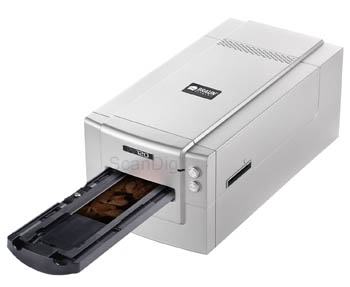
The film holder has to rais which can be swinged open. These are hold by magnets after closing. The fixation with the help of magnets is avery good solution, since it shows no wearing in the opposite to mechanical closures. The film lies firmly inside the film holder and there is no danger to break something when opening the film holder. You can unlock the lower rail with the help of a slider in its middle. So the lower rail can be shifted in order to strain the film. Such a mechanism also the medium format film holder of the Nikon 9000 use.
The medium format film holder is inserted into the scanner via the slot at the scanner front side. Also here the FS-120 has no automatic transportation system. However, this is not really necessary, since the film holder is shifted very simply into the scanner. The cutout of a maximum length of 14cm can now be captured completely by the FS-120. Thus the setting of the film format, as known from the Nikon 9000 or the Plustek 120, is not necessary. After the prescan one simply can define the scanning frame according to the size of the medium format film to be scanned.
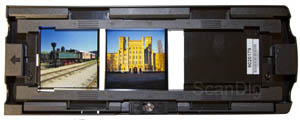
If you intend to scan a film strip with three 6x6 cm pictures, you first insert the film strip in that way, so that the first picture is on the left side. Then you take the film holder out of the scanner, open the fixing rails and turn the film strip by 180°. Now the picture no. 3 lies on the left side upside down. The film holder must be inserted into the scanner again, you make a new prescan and set the rotation angle to 180°. Now you can digitize the third picture on your film strip. Of course it is a bit more cumbersome than with the Nikon 9000, which can scan three 6x6 pictures automatically in batch mode, however, at least one can do without cutting the film strip.
After a prescan you will notice the boundaries of the film holder both on top and on buttom and on the left side. The exact scan area is 5,58 x 13,69 cm.
The scan software of the Braun FS-120
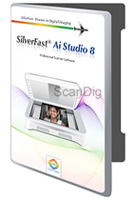
In the scope of delivery of the Braun FS-120 there is both the manufacturer's software CyberView and the professional scan software SilverFast Ai Studio 8. Optionally you can extend that software package by SilverFast HDR Studio and Adobe® Photoshop® Elements. Normally CyberView is only needed in order to install firmware updates, since this option is not included in the SilverFast scan software. Apart from that it is recommended to work with the high-value scan software SilverFast Ai Studio. This must be higher than version 8.0.1r26, as written in a previous chapter. You can also use the SilverFast Software for the reflecta MF-5000, because the drivers for both scanners are quite similar. So it is not a delivery error if the SilverFast scan software is labelled with Reflecta MF-5000.

Features like Multi-Exposure, the Auto IT-8 calibration and the NegaFix profile provide you with optimum scan results. If you scan positives, it is absolutely helpful to buy an additional IT-8 target for the calibration of the scanner. IT-8 calibration targets are available on Kodak films, Fuji films and Kodachrome films. In our online shop you find original Lasersoft Imaging IT-8 targets on different films and in different sizes. For the quality of the IT-8 calibration it does not matter, if you take a well approved 35mm target in a mount a larger targets (e.g. 6x7 cm). The 35mm targets in the slide mount have the great benefit that you can handle them easlily and that you don't have to care about bowings.
You can find detailed information about SilverFast Ai Studio 8 and SilverFast HDR Studio on our website Questions and answers about SilverFast.
Image quality of the Braun FS-120
Let's come to the most important point of our scanner test, the image quality. With every new scanner, especially with a medium format scanner, the usual question araises. Can the new scanner keep up with the longtime market leader Nikon SuperCoolscan 9000ED or is it even better? Let's first have a look at the data given by the manufacturer. Braun Phototechnik gives a maximum optical resolution of 3200 dpi. With this resolution a 35mm scan consists of 4535 x 3024 pixels. So one obtains a file with 13,7 megapixels out from a 35mm film. From a 6x6 medium format film one obtains with the highes resolution of 3200 dpi a digital image with 6930 x 6930 pixels. That means that a 6x6 medium format scans will consist of 48 million pixels.
At first these values sound promising. However, we will now make a resolution test with a USAF-1951 test target in order to find out how high the effective resolution is, which depends from more factors than from the number of image points captured by the CCD sensor (see our page resolution), which treats that topic in detail).
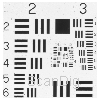
At a scan with the nominal resolution of 3200 dpi you can just differeniate the horizontal lines of the element 5.6 (which corresponds to 2896 dpi) and the vertical lines of the element 6.2 (which corresponds to 3649 dpi). These two values result in an averaged resolution of approx. 3270 dpi, which is 102% of the nominal resolution given by the manufacturer. This is a sensational result. For the first time we have measured with a scanner a higher resolution than the nominal resolution. At the latest here it becomes clear, that the Reflecta MF 5000, which achieves only 95% of the manufacturer's value, is not just a Braun FS-120 in a different case.
As a competitor of the Nikon Super Coolscan 9000 ED the Braun FS-120 has to compare with that top film scanner: The Nikon 9000 provides an effective resolution of 3900 dpi at a nominal resolution of 4000 dpi, which yields an image file of about 20 mega pixels(5528 x 3685 Pixel) out of a 35mm film. The resulting image file has about 58 MB in the uncompressed TIF-format. With this image information you can make high-value prints up to a size of 60x40 cm. This means, that the Nikon lies significantly ahead of the Braun FS-120.
Even clearer becomes the difference between the Braun FS-120 and the Nikon 9000, if one compares the numbers of a medium format scan: A 3200 dpi scan of a 6x6 medium format film results in an image file of about 7560 x 7560 pixels, i.e. 57,1 megapixel, at the Braun FS 120. Such a TIF-file has a file size of about 168 MB and can be enlarged up to 64 x 64 cm at a printer resolution of 300 dpi. A scan with the Nikon Super Coolscan 9000 ED with 4000 dpi, converted into the effective resolution of 3900 dpi, yields a file with 8445 x 8445 pixels for a 6x6 cm medium format film, i.e. an image with 71,3 million pixels and an image file size of about 204 MB. With such a scan an enlargement to approx. 72 x 72 cm is feasible at a printer resolution of 300 dpi.
With 102% effective resolution the Braun FS-120 exceeds indeed the Nikon Super Coolscan 9000 ED with its 98%, in absolute values, however, the Nikon 9000 stays at the top with its 3900 dpi effective resolution. In spite of this difference one can conclude that the Braun FS-120 achieves a very good resolution value in practice and that the resulting file size generally is sufficient for the most application fields. The Braun FS120 exceeds the resolution values of flatbed scanners - even high-value flatbed scanners - by far. Such a high-class flatbed scanner with transparency unit is, for example, the Epson Perfection V750 Pro. Let's compare the resolution of these two scanners with a medium format film scan:
The Epson V750 Pro delivers 6400 dpi according to the manufacturer's data. As you can read in our review, we could only measure 2300 dpi. A scan with the Epson V750 Pro of a 6x6 cm medium format film with an effective resolution of 2300 dpi delivers an image file with 4980 x 4980 pixels (24,8 mega pixels), which yields a file size of 71 MB. This scan can be printed with a printer resolution of 300 dpi up to a size of 42 x 42 cm - which is approx. 42% smaller than with the scan of the Braun FS-120. Since the Epson Perfection V750 Pro is one of the best flatbed scanners on the market we can conclude:
In terms of resolution the Braun FS-120 outmatches any flatbed scanner with transparency unit significantly and hence gets a clear recommendation for scanning medium format films.
Finally we compare the Braun FS-120 with the Plustek OpticFilm 120. The Plustek scans with a nominal resolution of 5300 dpi and achieves an effective resolution of 3450 dpi. In terms of effective resolution the Plustek OpticFilm 120 outmatches the Braun FS-120 a bit. However you buy the 180 dpi more resolution at the Plustek OpticFilm 120 with extremely slow scans, which contain numerous double pixels, so that you have to compress the image data after scanning in order to restrict the image file to the real image content. You can do without this compression procedure at the Braun FS-120 as the first scanner at all, since the Braun does not deliver double pixels.
The Braun FS-120 is the first scanner which delivers effectively the same amount of pixels as nominally. So you can do without a time consuming compression after scanning.
Let us next look at the density range, which is given by the manufacturer as Dmax > 3,6. From this value one can conclude that the density range is a bit higher than 3,0, which is not an excellent value. Comparable medium format scanners like the Reflecta MF-5000 or the Plustek OpticFilm 120, however, lie also in that area. Hence the feature Multi-Exposure within the SilverFast scan software is absolutely necessary for high contrast scans. According to the software manufacturer Lasersoft Imaging Multi-Exposure increases the density range by up to 1 at some scanner models, which means that the Braun FS-120 might reach a density range of approx. 4 with the multi exposure function.
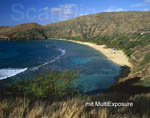
The adjacent picture shows a beach situation which is scanned once with and once without multi exposure. If you click at the thumbnail a larger windows opens and the view changes between the two scans. For the scans of the slides we have calibrated our test device with a 6x7 cm IT-8 target on Kodak film. Generally we recommend to perform an IT-8 calibration when scanning positive films. You can find detailed information about that topic on our page scanner calibration. You can easily recognize which quality increase multi exposure effects. Whilst the scan without that feature at first seams to be also good, by comparing the two scans one notices that the scan with multi exposure has much more contrast and seems to glow.
So the multi exposure function within SilverFast Ai Studio definitely yields an increase of the image quality at the Braun FS-120. >You will realize that even clearer, if you compare 10 or 20 scans with and without multi exposure. In spite of the multi exposure, however, the Braun FS-120 does not achieve the performance of the Nikon Super Coolscan 9000 ED. Anyway it beats all high-class flatbed scanners, like the already mentioned Epson Perfection V750 Photo.

Next we have a look at the automatic dust and scratch correction function. In SilverFast it is designated as iSRD. If you click at the adjacent image, a new window opens with the red marked image detail enlarged. The view changes here between the scan with iSRD and without. You can recognize very well that the dust and scratch correction function really does what it is supposed to do. Especially at the sky and at the sign of the bus stop you can see, that the dust and scratch removal function has removed all smaller and bigger particles. So you can do without a laborious spot retouching at the Braun FS-120. You only have to do it at black/white photos, since the automatic dust and scratch removal function cannot be applied for black&white films.
The automatic dust and scratch removal function works very well at the Braun FS-120 and delivers excellent images.
Since the Braun FS-120 is delivered with SilverFast by default, we do without a comparison between scans made with CyberView and SilverFast. SilverFast would win the duel in any case. As already mentioned the CyberView software is only necessary in order to install firmware updates. How to install a firmware update is explained in detail on our page FaQ DigitDia.

Next we have a look at scanning negatives with the Braun FS-120. In order to do this SilverFast offers the NegaFix dialogue. With the animation we want to show you how easy it is to choose the rilm type to be scanned. First you select, if it is a slide, a negative or a Kodachrome. Next you make a prescan. Then you choose the film manufacturer in the NegaFix dialogue. In our case we want to scan a Fuji-film. Then we select the excat film type. Our film is a Fuji Superia 200. The ISO/ASA number can also be set. With all these settings you have provided the best prerequisite to scan negatives quickly and with true colors.
For high sensitive films (starting at ISO 400) the GANE function for smoothing the film grain is very recommendable. This increases the image quality, since the film grease is not visible significantly any more if you enlarge the image. Even at HDR Scans you can directly choose the film type within the NegaFix dialogue. Howevere, only the info is beeing embedded into the image file and the film settings can be selected in the HDR software.
All in all one can say that the Braun FS-120 provides a very good image quality, even if it does not reach the top quality of the Nikon Super Coolscan 9000 ED.
Finally we compare the Braun FS-120 with the Plustek OpticFilm 120, by directly comparing two scans with both scanners.
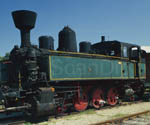
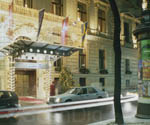
If you click at a thumb nail a new window opens with the enlargement of one detail for an easier comparison. At the of pictures of a railway and an hotel entrance it becomes clear, that the automatic scratch and dust removal function of the Braun FS-120 works significantly better that that of the Plustek medium format scanner. One can also recognize, that the scan made with the Braun scanner, especially the railway picture, is clearly sharper than the scan made with the Plustek OpticFilm 120.
At the contrast one can hardly see a difference, and also in terms of colour the two scans are almost identical, since both times an IT-8 colour calibration has been done. All in all one can conclude that the Braun FS-120 is superior to the Plustek OpticFilm 120 in terms of image quality. So let us conclude:
In terms of image quality the Braun FS-120 beats its competitors Reflecta MF-5000 and Plustek OpticFilm 120. However, it can not reach a Nikon LS-9000 ED or a Hasselblad Flextight X1/X5.
All in all we have been very surprised about the good image quality of the Braun FS-120. Especially the high effective resolution, which even beats the nominal resolution, and the very well working dust and scratch removal function are impressing.
The scanning speed of the Braun FS-120
In order to measure the scanning times of the Braun FS-120 we have connected the scanner via USB 2.0 to a PC with Core i5-3450 CPU and 8 GB memory. The used software was SilverFast 8.0.1r26. Since one usually scans only with the nominal resolution of 3200 dpi, we have made measurements only with that resolution. In the following table you find the measured values:
| Event |
Duration without iSRD |
Duration with iSRD |
| Prescan 35mm film |
0:14 min |
- |
| 35mm positive scan with 3200 dpi resolution |
0:52 min |
1:18 min |
| 35mm negative scan with 3200 dpi resolution |
0:54 min |
1:19 min |
| Preview medium format |
0:38 min |
- |
| 6x6cm positive scan with 3200 dpi resolution |
3:21 min |
4:05 min |
| 6x6cm negative scan with 3200 dpi resolution |
3:28 min |
4:07 min |
If you look at the values in the table you will recognize immediately that the Braun FS-120 is a very fast scanner. Only a few scanners can do a 35mm scan with automatic scratch and dust removal function within 60 seconds. Even the magazine scanner Braun Multimag SlideScan 6000 from the same manufacturer takes about the double amount of time for a 35mm scan. Let's better compare the values with other medium format scanners.
The Braun FS-120 is a bit faster than the similar Reflecta MF5000. So the Braun FS-120 scans a 6x6 medium format positive or negative within approx. 4 minutes while the Reflecta MF-5000 takes about 4,5 minutes. We have to mention, that the speed of the Braun FS-120 was measured with SilverFast Ai Studio whilst the speed of reflecta MF-5000 was measured with CyberView. Furthermore, the test of the Braun FS-120 was done with a faster computer.
Much more interesting is the comparison of the Braun FS-120 with the Plustek OpticFilm 120. At this comparison one can realize glaring differences in the scanning speed. In order to make a scan with effectively 3450 dpi with the Plustek 120 you have to scan with the nominal resolution of 5300 dpi. With its nominal resolution the Plustek OpticFilm 120 takes about 6 minutes for a 35mm scan and about one hour for a 6x7 cm medium format scan. As result one obtains highly bloated image files which have to be compressed in the image editing program subsequently. The Braun FS-120 provides 3270 dpi effectivy resolution when scanning with its nominal resolution. So in the 35mm film area then Braun is about 5 times faster than the Plustek, in the medium format area it is even 15 times faster. The subsequent compression must not be applied, since the nominal resolution corresponds to the effective resolution. So the Braun FS-120 wins the scanning time comparison against the Plustek OpticFilm 120 extremely clearly.
If we finally compare the Braun FS-120 with the Nikon Super Coolscan 9000ED we take out from the tables, that both devices are approximately similar in terms of speed. However, if one considers, that the Nikon speed values have been measured with computers from the year 2004 and that the nominal resolution is 4000 dpi (effective 3900 dpi), then the Nikon is definitely the winner in terms of scanning speed, even if the advance is not very high. So let us hold:
The Braun FS-120 is a very fast film scaner, both in the 35mm field and in the medium format field.
With a scan time of about one minute for a 35mm film and a scan time of about 4 minutes for a 6x6 cm medium format film even professional photographers can live with very well, and the scanner is even suitable to digitize larger amounts of films in an acceptable time.
Summary, conclusion
The Braun FS-120 is a very excellent film scanner for 35mm films and medium format films. It stands out by a very good image quality and a very high scanning speed. With an effective resolution of 3270 dpi it is the first scanner, since we have been testing film scanners, which achieves the nominal resolution (3200 dpi) in practice by 100% and even exceeds that.
The Braun FS-120 beats its direct competitors Reflecta MF-5000 and Plustek OpticFilm 120 because of its very fast scanning speed. In terms of image quality the 3 scanners lie at a similar level, then Braun FS-120, however, is a bit ahead. Anyway, the Braun FS-120 cannot keep up with the professional medium format scanners from Nikon or Hasselblad; these high-value scanners play in a different category. Also in a different (much lower) category there are the flat scanners with transparency unit from Epson, Canon or Microtek. The Braun FS-120 beats these flatbed scanners in all areas.
Due to the very good image quality, the extremely high scanning speed, the well working automatic dust and scratch correction function and the achievement of the nominal resolution by 100% in practice we can declare the Braun FS-120 as the top recommendation for a medium format scanner in the middle price area at the moment.
Back to the film scanner tests index
|